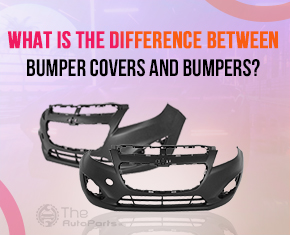Most individuals who are unfamiliar with automobiles will be perplexed when they hear the word “bumper cover.” Is that any different than a bumper? What is its purpose?
People may have difficulty distinguishing between bumpers and bumper coverings. However, not understanding the difference can lead to you purchasing the incorrect part, so let’s clear up the uncertainty once and for all by discussing the differences between these two car components.
What exactly is a bumper?
A bumper was once a substantial metal component attached to the front of a vehicle. But that isn’t always the case nowadays. Although most individuals presume the bumper is the noticeable, front fascia of a modern car, it’s genuinely a hidden structure behind the bumper cover. A visible bumper is still used in a few situations, such as heavy-duty pickup trucks.
Bumpers of all types are meant to absorb part of the force of a collision, acting as a barrier between your car and the other vehicle involved in the accident. This guarantees that some of the most critical components beneath the hood take less of the stress, lowering your repair expenses.
Modern bumpers, in particular, are built to withstand tiny dents and low-speed collisions. Energy absorbers are located behind the bumper (also known as bumper reinforcement).
What exactly is a bumper cover?
The bumper cover is a transparent, moulded body feature that is usually composed of plastic or fibreglass. This is the section of the front end that many people mistake for the bumper.
The bumper cover is attached to the front of the bumper. Essentially, the bumper cover’s purpose is to create an inconspicuous visual appeal. Bumper coverings also increase aerodynamics and as a result, fuel economy.
When Do You Need a Bumper Cover?
It’s normally up to you whether to replace your front bumper cover or your rear bumper cover. If you need further convincing, here are some reasons why you might need a new bumper cover:
1.”The paint was flaking away” – Your car’s paint job, no matter how tough it is, can be harmed by the environment over time. When this happens, the paint either dries out due to the heat or expands owing to the dampness. If you see evidence of deterioration on your bumper cover, it may be time to replace it.
2.”That old bumper was decaying” – Deterioration can refer to a variety of factors. Anything might physically decline, but it can also be “aesthetically deteriorated,” or, in layman’s terms, you discover that your car’s exterior needs a makeover.
3.”It already had a lot of dents” – While dents may not necessarily indicate important damage, nevertheless can be unsightly. If you’re sick of staring at your damaged bumper cover, this rationale should be enough to convince you to get that new bumper cover you’ve been admiring.
When Should You Purchase a Bumper?
Bumpers, on the other hand, are far more easily justified. This is because, while bumper coverings may be replaced for cosmetic reasons, bumpers are truly meant to aid limit damage after a bad accident or collision.
As a result, the main factor to consider when purchasing a bumper is whether or not it is still functioning after a collision. What you should know is that if your bumper is shattered in an accident, you should repair it as quickly as possible, and other pieces of your automobile may need to be replaced as well.
Before purchasing a replacement bumper cover or bumper, be sure that it is CAPA-certified. The Certified Automobile Parts Association (CAPA), which is recognised by the whole automotive industry, is an independent organisation that evaluates replacement parts for fit, quality, and safety to the highest standards. If you pick a CAPA-certified bumper or bumper cover, you can be confident that it has passed rigorous crash testing, giving you and your passengers complete peace of mind. Log on to theautopartsshop.com
